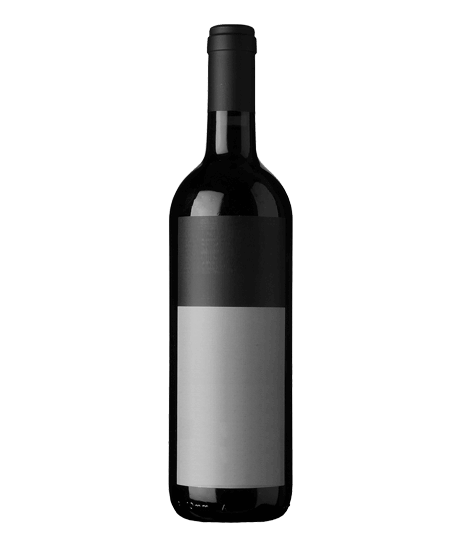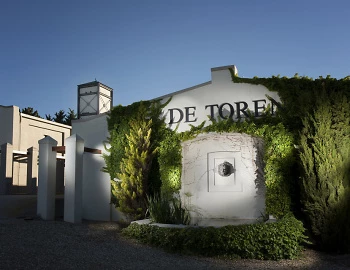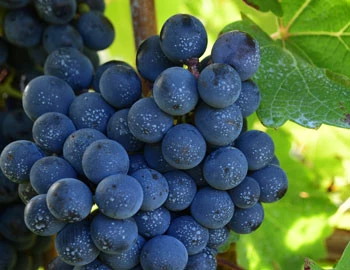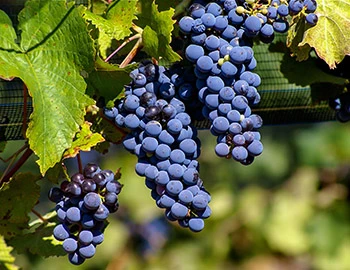
Fusion V Director's Reserve 2017
Stellenbosch, De Toren, 750 ml

| Grape variety: | Cabernet Sauvignon, Malbec |
| Producer: | De Toren |
| Origin: | South Africa / Coastal Region / Stellenbosch |
Attributes
| Origin: | South Africa / Coastal Region / Stellenbosch |
| Grape variety: | Cabernet Sauvignon, Malbec |
| Ripening potential: | 5 to 15 years |
| Drinking temperature: | 15 to 18 °C |
| Food Pairing: | Spiced grillades, Wild specialities, Bistecca fiorentina, T-Bone steak, Saddle of lamb fillet with herb jus |
| Vinification: | Pumping over |
| Harvest: | hand-picking with simultaneous grape sel, strict selection |
| Maturation: | in partly new and used barriques/ Pièces |
| Maturation duration: | 24 months |
| Volume: | 14.5 % |
| Note: | Contains sulphites |
De Toren
De Toren is one of the first wineries in South Africa to producing classic Bordeaux-style wines. Since its foundation, the De Toren vision has been and remains the reinterpretation of the Bordeaux concept and to create unique South African wines from the five grape varieties Cabernet Sauvignon, Merlot, Cabernet Franc, Malbec and Petit Verdot. De Toren is one of the first wineries in South Africa to producing classic Bordeaux-style wines. Since its foundation, the De Toren vision has been and remains the reinterpretation of the Bordeaux concept and to create unique South African wines from the five grape varieties Cabernet Sauvignon, Merlot, Cabernet Franc, Malbec and Petit Verdot.
This acclaimed winery is located at the highest point of the Polkadraai Road in the Polkadraai Hills, boasting a view over False Bay and onward to the Atlantic Ocean.

Cabernet Sauvignon
The backbone of Bordeaux
The Cabernet Sauvignon gives the Bordeaux its backbone, yielding deep violet wines with powerful tannins and endless ripening potential. It is the top dog in Médoc, and is placed in all five premier crus of Bordelais. When young, it often appears strict and unapproachable, but with advancing years, its tannins round off. It is wonderfully velvety, and yet always maintains its freshness. Typical flavours include cassis, graphite and cedar. Wherever Cabernet Sauvignon is found, Merlot is not far away. It complements the robust structure of Cabernet with softness, fruit and richness. The Cabernet Sauvignon is the most-exported vine in the world. It delivers persuasive qualities in Italy as an ingredient of the Super Tuscan, or as the flagship variety from California. There, it is lovingly titled “Cab Sauv”. Meat fans should be aware that it fantastically accompanies a grilled entrecôte. The family tree of Cabernet Sauvignon is surprising: its parents are Cabernet Franc and the white Sauvignon blanc.

Malbec
New Home, New Fortune
The Malbec once belonged to the classic assortment of varieties from Bordeaux. But it was demanding to cultivate, and in the changeable climate of the Bordelais it often became green and herbaceous, so winemakers replaced it with Merlot in the middle of the 20th century. Luckily, the Malbec found a new home in Argentina. In 1868, a Frenchman brought the first stocks along to the land of the Andes. Today, the Malbec is the most-planted variety there. Especially in Mendoza, it shows what it can do: it yields very dark, well-structured wines with aromas of black fruit, violets and game. They just call out for an Argentinean steak! The Malbec has its origins in Cahors, in southwestern France. There, it is kept today under the name Cot. Due to their earthy tannins, in the middle ages the growths from this area were also called "the black wines of Cahors".


